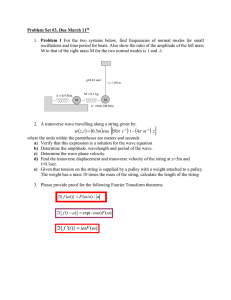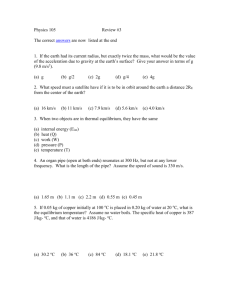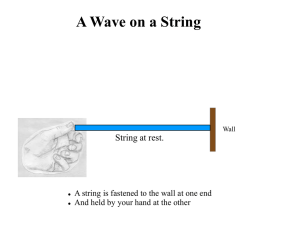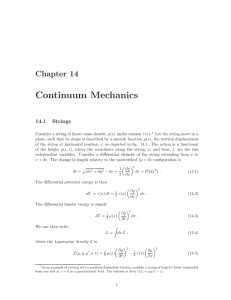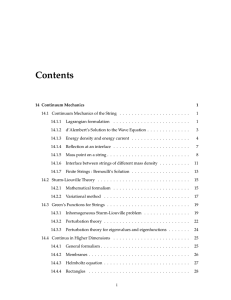PHYSICS 200A : CLASSICAL MECHANICS PROBLEM SET #5
advertisement
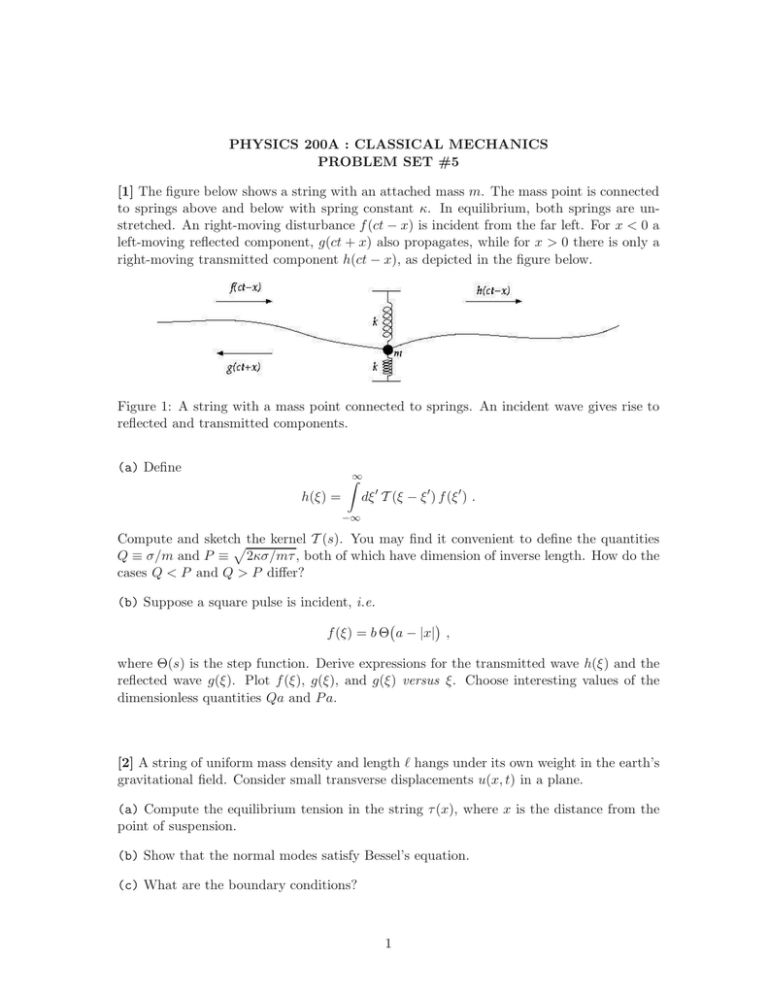
PHYSICS 200A : CLASSICAL MECHANICS PROBLEM SET #5 [1] The figure below shows a string with an attached mass m. The mass point is connected to springs above and below with spring constant κ. In equilibrium, both springs are unstretched. An right-moving disturbance f (ct − x) is incident from the far left. For x < 0 a left-moving reflected component, g(ct + x) also propagates, while for x > 0 there is only a right-moving transmitted component h(ct − x), as depicted in the figure below. Figure 1: A string with a mass point connected to springs. An incident wave gives rise to reflected and transmitted components. (a) Define Z∞ h(ξ) = dξ ′ T (ξ − ξ ′ ) f (ξ ′ ) . −∞ Compute and sketch pthe kernel T (s). You may find it convenient to define the quantities Q ≡ σ/m and P ≡ 2κσ/mτ , both of which have dimension of inverse length. How do the cases Q < P and Q > P differ? (b) Suppose a square pulse is incident, i.e. f (ξ) = b Θ a − |x| , where Θ(s) is the step function. Derive expressions for the transmitted wave h(ξ) and the reflected wave g(ξ). Plot f (ξ), g(ξ), and g(ξ) versus ξ. Choose interesting values of the dimensionless quantities Qa and P a. [2] A string of uniform mass density and length ℓ hangs under its own weight in the earth’s gravitational field. Consider small transverse displacements u(x, t) in a plane. (a) Compute the equilibrium tension in the string τ (x), where x is the distance from the point of suspension. (b) Show that the normal modes satisfy Bessel’s equation. (c) What are the boundary conditions? 1 (d) What are the normal mode frequencies? (e) What are the normal modes? (f) Construct the general solution to the initial value problem. [3] A string of length 2a is stretched to a constant tension τ with its ends fixed. The mass density of the string is given by |x| σ(x) = σ0 1 − . a (a) Use a zero-parameter trial function to derive a variational estimate of the lowest resonant frequency ω1 . Compare with the numerical value ω12 ≈ 3.477 τ /a2 σ0 . (b) Devise a one-parameter trial function and show that it leads to a better (e.g. lower frequency) estimate. (c) Repeat part (a) for the next eigenfrequency ω2 , whose numerical value is ω22 ≈ 18.956 τ /a2 σ0 . [4] A wave travels along an infinite string stretched to a tension τ . The mass density of the string is σ0 for |x| > a and σ1 for |x| < a. (a) Solve the wave equation in the regions |x| > a and |x| < a, respectively, to find exact expressions for the transmission and reflection amplitudes. (b) Show that the energy transmission coefficient is given by T =1−R= ( 1+ k12 − k02 2k0 k1 2 )−1 sin2 (2k1 a) , p where ki = σi /τ ω = ω/ci . Discuss the frequency dependence of T , noting the position and widths of the transmission resonances (where T = 1). [5] Consider a uniform circular membrane of radius a, areal mass density σ, and tension τ . (a) A point mass m is attached at the center of the membrane. Show that the total density is now m δ(r) . σ(r, φ) = σ + πr 2 (b) Use first-order perturbation theory to show that only the circularly symmetric modes are affected by the point mass, in which case ( ) m k2 a2 = x20,n 1 − , πσa2 J12 (x0,n ) where Jν (xν,n ) = 0, i.e. xν,n is the nth root of Jν (x). Discuss the behavior for large n and compare to the corresponding case of a point mass on a string. 3



